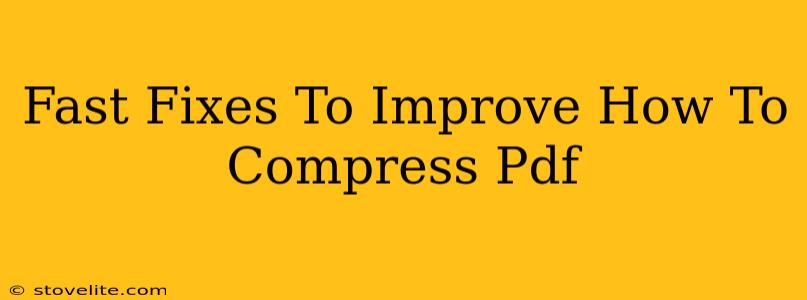So, you've got a PDF that's taking up way too much space. Maybe it's a hefty report, a collection of high-resolution images, or a scanned document. Whatever the reason, a bloated PDF is a problem. Luckily, there are some fast fixes to dramatically shrink your files without losing too much quality. Let's dive in!
Understanding PDF Compression: Why Size Matters
Before we jump into the solutions, let's quickly understand why PDF compression is so important. Large PDFs:
- Take longer to upload and download: Frustrating for you and anyone sharing the file.
- Use more storage space: This can be a significant issue if you're working with many large files.
- Slow down email delivery: Nobody likes waiting for a huge attachment.
- Impact website performance: If you're embedding PDFs on a website, large files can significantly slow down loading times.
Fast Fixes for Compressing Your PDF
Here are several quick methods to compress your PDFs, ranging from simple online tools to more advanced software options:
1. Online PDF Compression Tools
Many free online tools offer quick and easy PDF compression. These are perfect for single files and don't require any software installation. Just upload your PDF, choose your compression level (usually offering options like "low," "medium," and "high" quality), and download the smaller version. Remember to check the terms and conditions of any online tool before uploading sensitive information.
2. Built-in Compression Features in PDF Software
If you use PDF software like Adobe Acrobat Pro (paid) or some free alternatives, they often have built-in compression features. Look for options within the "File" or "Save As" menus. These typically offer different compression settings, allowing you to balance file size reduction with image quality.
3. Image Optimization Before Creating the PDF
This is a proactive approach. If you're creating a PDF from images, optimize those images before converting them to PDF format. Reduce image resolution and file size using image editing software (like Photoshop, GIMP, or even free online tools). This significantly reduces the final PDF's size before you even start. Consider using the appropriate image format (like JPEG for photos and PNG for graphics) to ensure best results.
4. Removing Unnecessary Elements
Sometimes, a large PDF is just bloated with unnecessary elements. If you're comfortable working with PDF editing software, try removing any redundant pages, layers, or embedded elements that aren't essential. This can drastically reduce the file size.
5. Choosing the Right Compression Method
Different compression methods prioritize different aspects. Some prioritize speed, while others focus on minimizing file size. Experiment to find the best balance between size and quality for your specific needs.
Advanced Techniques for PDF Compression
For advanced users needing even greater control over the compression process, more specialized software options offer finer-grained control over compression settings and allow for more aggressive reduction of file size. Researching software specific to PDF optimization can unlock more advanced options, though these often come with a cost.
Optimizing Your PDF Workflow: Proactive Steps
To avoid large PDF files in the future, consider these proactive measures:
- Use vector graphics when possible: Vector graphics (like SVGs) scale without losing quality, resulting in smaller file sizes compared to raster graphics (like JPEGs and PNGs).
- Control image resolution: Don't use higher resolution images than necessary.
- Choose the right PDF standard: The PDF standard itself can influence file size.
By implementing these fast fixes and adopting a more mindful approach to PDF creation, you can significantly reduce your file sizes and improve overall efficiency. Remember to always back up your original files before performing any compression, just in case!

